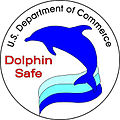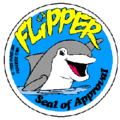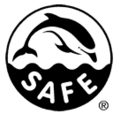- Dolphin safe label
-
There are various dolphin safe labels used for canned tuna to imply that the fish has been caught without harming or killing dolphins. However, because there are various labels used, there are also various restrictions imposed on the capture of tuna in order for it to deserve the related dolphin safe label, some labels imposing stricter requirements than others.
According the US Consumers Union, there is no guarantee that dolphins have not been harmed, despite the various labels. This is because there is no universal and independent verification of the dolphin-friendly claims, by observers, for example, who board fishing boats or make surprise visits to canneries to inspect captains' logs.[1] However, some labels do require such verification.
In a report released by Greenpeace in 2008, it is noted that the dolphin safe labels may make consumers believe that canned tuna with a dolphin safe label is also environmentally friendly in general, while these labels only cover the by-catch of dolphins and not that of other species, the sustainability of the hunt itself nor the environmental impact of it.[2] Species such as sharks and albatross still suffer greatly from tuna fishing.
On September 15, 2011, the World Trade Organization banned the practice of using dolphin safe labels.[3] The results of this ruling are not yet known, but a country that continues a policy banned by the WTO may face sanctions.
Background
Dolphins are a common bycatch in tuna fisheries, especially in the Eastern Tropical Pacific Ocean, as dolphins in this area can often be found swimming together with schools of tuna, specifically yellowfin tuna. Not only do the dolphins end up as accidental bycatch, the dolphins themselves may also be used as a way to find the tuna as they are easier to spot because the dolphins usually swim closer to the surface. The dolphins are sometimes knowingly being netted together with the fish.
Dolphins do not associate with Skipjack tuna and this species is most likely to be truly "dolphin safe".[1] The species of tuna is not always mentioned on the can.
List of dolphin safe labels
Dolphins safe labels The United States Department of Commerce dolphins safe label was established in 1990. Standards for this are that tuna caught using purse seine fishing methods within Eastern Tropical Pacific Ocean did not involve the deliberate netting or circling of any dolphins. This must have been verified by an observer from the National Marine Fisheries Service on the fishing ship that caught the fish. Tuna caught using a different method or in most places outside of this area may be given this label without any outside observation having been made.[4] The Flipper Seal of Approval dolphin safe label is an initiative by the organisation EarthTrust. Most notable requirements are that it does not allow the label on tuna fish caught using driftnets or gillnets, or by the intentional setting of purse seine nets on dolphins or any tuna caught in the Eastern Tropical Pacific Ocean except for hook and line fisheries. Independent observers from EarthTrust must be allowed to monitor the fishing process.[5] This dolphin safe tuna label is an initiative from the Earth Island Institute. Requirements to be met are that dolphins may not intentionally be chased, circled or netted during any fishing trip, drift- or gillnets cannot be used and no accidental dolphin death or serious injury may result from the fishing operation. Fish from a dolphin unfriendly source may not be mixed in at any stage. Each trip in the Eastern Tropical Pacific Ocean by vessels 400 gross tons and above must have an independent observer on board attesting to the compliance with the points mentioned.[6] 
This label is used on Greenseas tuna cans in Australia. According to Greenseas the tuna will not have been caught in the Eastern Tropical Pacific Ocean, nor will drift- or gillnets have been used during the capture. The tuna is caught in either Australian waters or in the Western Pacific Ocean. Greenseas also meets the standards set by the Earth Island Institute.[7] This label is used on John West Australia tuna cans. According to John West Australia, the tuna is exclusively caught using line fishing. It also meets the standards set by the Earth Island Institute mentioned above.[7][8] A Dutch label used by Princes foods on tuna cans. The text translates to "Caught dolphin friendly". More often, the label is in English however and Princes products are also sold in many other European countries, especially the United Kingdom. According to the company, the label assures that no dolphins were chased or netted while fishing for tuna and that the boats try to only fish for tuna with no dolphins present, and dolphins that do accidentally end up in nets are released. It also meets the standards set by the Earth Island Institute mentioned above.[7][9] 
Sealord, a major fishing company in New Zealand, has a dolphin friendly label. The company states that they purchase tuna from companies that are certified and monitored by the Earth Island Institute.[7][10] References
- ^ a b Choice Magazine, issue April 2006.
- ^ Greenpeace, Canned Tuna's Hidden Catch. Report retrieved October 21, 2008.
- ^ http://citizen.typepad.com/eyesontrade/2011/09/flipper-again-on-the-wto-chopping-block.html
- ^ Greenerchoices.org, page retrieved August 6, 2007.
- ^ Earthtrust.org, page retrieved August 6, 2007.
- ^ Earthisland.org - consumer information, page retrieved August 6, 2007.
- ^ a b c d Earth Island Institute - Approved Dolphin-Safe Tuna Processing Companies & Fishing Companies, January 2011, page retrieved January 26, 2011.
- ^ John West Australia website, page retrieved August 6, 2007.
- ^ Dutch Princes Foods website, quality section, page retrieved August 6, 2007.
- ^ Sealord - Sealord Community
Categories:- Fishing industry
- Ecolabelling
- Cetacean research and conservation
Wikimedia Foundation. 2010.




